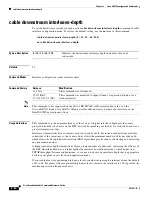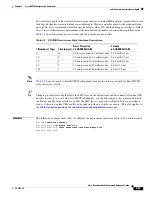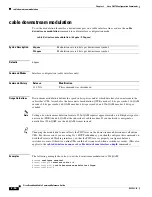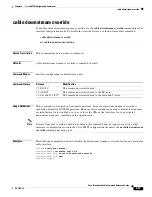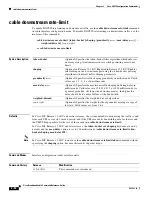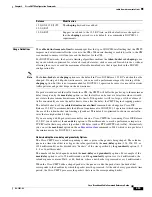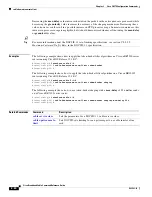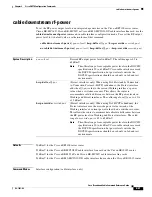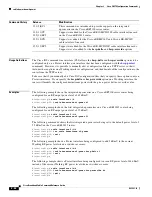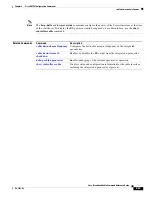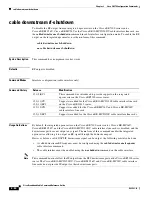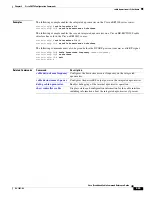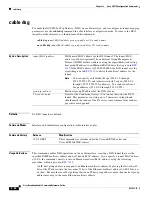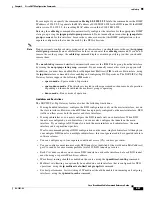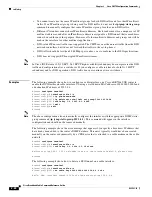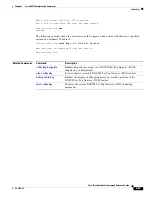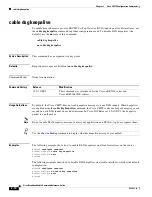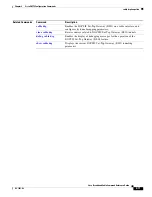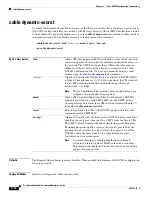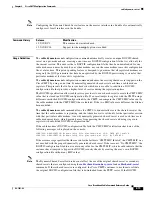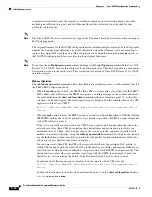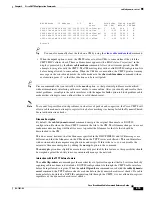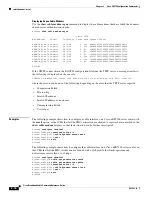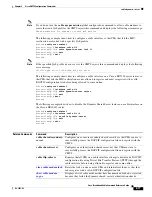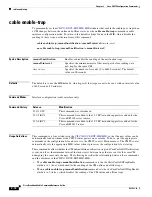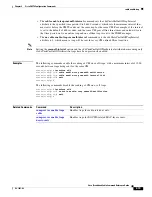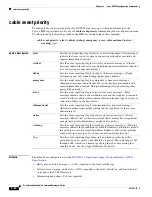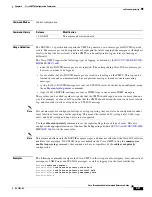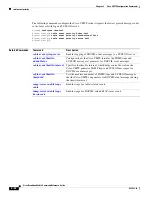
2-67
Cisco Broadband Cable Command Reference Guide
OL-1581-08
Chapter 2 Cisco CMTS Configuration Commands
cable dsg
For example, if you specify the command
cable dsg 0.0.0 228.9.9.9 AAA
, the command uses the IGMP
IP address of 228.9.9.9 to generate the MAC address of 0100.5E09.0909 for the DSG tunnel. If the IGMP
address were 228.129.9.9, the resulting MAC address would be 0100.5E01.0909.
Entering the
cable dsg
command also automatically configures the interface for the appropriate IGMP
static group, using the
ip igmp static-group
command. Do not manually enter another
ip igmp static-
group
command for this interface, because the system assumes that this IGMP configuration is for a
separate configuration that cannot be used by the DSG subsystem.
Note
If any previously configured static groups exist on this interface, you should remove those other
ip igmp
static-group
commands on a cable interface before you can enter the
cable dsg
command. If you do not
remove those other groups, the
cable dsg
command displays a warning notifying you that you should
remove them.
The
no cable dsg
command similarly automatically removes the IGMP static group from the interface
by issuing the
no ip igmp static-group
command. Do not manually remove this static group yourself.
In addition, you must have enabled Protocol Independent Multicast (PIM) on the cable interface, using
the
ip pim
interface command, before enabling and configuring DSG operations. The DOCSIS Set-Top
Gateway feature supports the following PIM modes:
–
sparse-mode
—Sparse mode of operation.
–
sparse-dense-mode
—The interface is treated in either sparse mode or dense mode of operation,
depending on the mode in which the multicast group is operating.
–
dense-mode
—Dense mode of operation.
Limitations and Restrictions
The DOCSIS Set-Top Gateway feature also has the following limitations:
•
If using bundled interfaces, configure the DSG configurations only on the master interface, not on
the slave interfaces. However, when DSG has been properly configured on the master interface, DSG
traffic can flow across both the master and slave interfaces.
•
If using subinterfaces, you must configure the DSG tunnels only on subinterfaces. When DSG
tunnels are configured on a subinterface, you cannot also configure the tunnels on the main
interface. If you configure DSG tunnels on both the main interface and subinterfaces, the main
interface can drop multicast packets.
We also recommend putting all DSG configurations on the same, single subinterface. Although you
can configure DSG tunnels on multiple subinterfaces, this is not guaranteed to be supported in future
software releases.
•
You can configure up to four separate conditional access (CA) vendors per router.
•
You can configure a maximum of eight DSG tunnels (as identified by the well-known MAC address)
per CA vendor, for a maximum possible total of 32 DSG tunnels per router.
•
Each CA vendor can have one or more DSG tunnels on each cable interface, but each DSG tunnel
must be using a separate IP multicast address.
•
IP multicast routing should be enabled on the router, using the
ip multicast-routing
command.
•
Multicast rate-limiting can optionally be enabled on a cable interface that is configured for DSG
operations, using the
ip multicast rate-limit out group-list
command.
•
For best performance, fast switching of IP multicast should be enabled on incoming and outgoing
interfaces, using the
ip mroute-cache
command.


